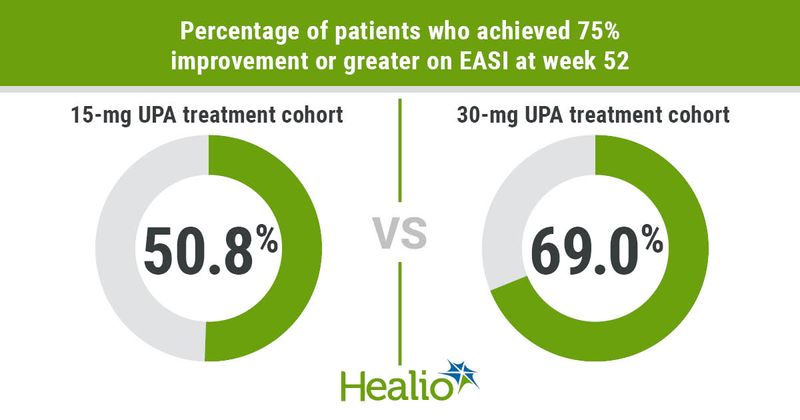Upadacitinib, topical corticosteroids combination safely treats atopic dermatitis
Patients with mild to severe atopic dermatitis may benefit from long-term upadacitinib and topical corticosteroid treatment without any new safety risks, according to a study published in The Journal of Allergy and Clinical Immunology.
Upadacitinib (Rinvoq, AbbVie) is an oral JAK inhibitor that has greater inhibitory potency for JAK1 than JAK2, JAK3 or tyrosine kinase 2, Jonathan I. Silverberg, MD, of the department of dermatology at the George Washington University School of Medicine and Health Sciences in Washington, D.C., and colleagues wrote.

The U.S., European Union and other countries have approved the use of upadacitinib to treat moderately or severely active rheumatoid arthritis, and it is now being developed to treat atopic dermatitis (AD) and other immune-mediated inflammatory conditions.
The ongoing phase 3, double-blind, placebo-controlled AD Up study involved 901 patients with moderate to severe chronic AD aged 12 to 75 years attending 171 clinical centers around the world.
Patients were randomly assigned to daily doses of 15 mg of upadacitinib plus topical corticosteroids (TCS) (n = 300), 30 mg of upadacitinib and TCS (n = 297) or placebo and TCS (n = 304). The placebo cohort was then randomly assigned at week 16 to receive TCS and either 15 mg or 30 mg of upadacitinib.
When there were areas with active lesions, patients also would apply a medium-potency TCS for up to 3 consecutive weeks until the lesions were clear or almost clear. They would then apply low-potency TCS once a day for 7 days and stop if the lesions were no longer active.
The combined upadacitinib and TCS treatments maintained the efficacy they achieved at week 16 through week 52, and the patients tolerated them well through the 52-week period, the researchers said.
Specifically, 50.8% (95% CI, 45.1% to 56.5%) of the 15 mg upadacitinib treatment cohort and 69% (95% CI, 63.7% to 74.3%) of the 30 mg upadacitinib treatment cohort achieved a 75% improvement or greater on the Eczema Area and Severity Index (EASI) at week 52.
The 15 mg cohort also saw 37.7% (95% CI, 32.1% to 43.3%) achieve 90% EASI improvement or greater, with 13.1% (95% CI, 9.2% to 16.9%) achieving 100% improvement, while the 30 mg cohort saw 55.4% (95% CI, 49.7% to 61.2%) achieve 90% EASI improvement or greater, with 23.6% (95% CI, 18.8% to 28.5%) achieving 100% improvement.
Patients who began with a placebo and were then randomly assigned to an upadacitinib dose improved as well, with 79.1% (95% CI, 71.7% to 86.6%) of those taking 15 mg and 84.7% (95% CI, 77.3% to 92.1%) of those taking 30 mg achieving 75% EASI improvements.
Additionally, 33.5% (95% CI, 28.1% to 38.9%) of the 15 mg and 45.2% (95% CI, 39.5% to 50.9%) of the 30 mg cohorts achieved the validated Investigator Global Assessment for AD of clear or almost clear with two grades of improvement or more, while 45.3% (95% CI, 39.5% to 51%) of the 15 mg cohort and 57.5% (95% CI, 51.8% to 63.2%) of the 30 mg cohort achieved an improvement of 4 points or more on the Worst Pruritus Numerical Rating Scale.
Acne, nasopharyngitis, blood creatine phosphokinase increases, dermatitis atopic and upper respiratory tract infections were among the most frequently reported treatment-emergent adverse events. None of the acne events were serious, the researchers said.
Most of the hepatic disorders that occurred were transient, asymptomatic transaminase elevations. Major adverse cardiovascular events and venous thromboembolic events were rare, and no deaths were reported, prompting the researchers to conclude that upadacitinib has an overall favorable benefit-risk profile for treating AD.
However, the researchers cautioned that their study used a relatively small sample size and lacked powered statistical comparison between groups from weeks 20 to 52, so its results should be examined in context. Additionally, the efficacy results are based on objective vs. subjective outcomes.
In the future, the researchers said, analyses will examine the long-term impact of upadacitinib and TCS treatment on patient-reported outcomes, health-related quality of life, rescue medication use, TCS-free days and disease flare incidence during the blinded extension period.
